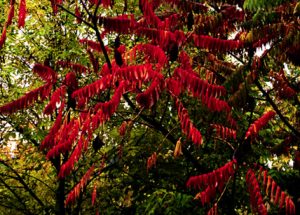Bulletin #2579, Native Trees and Shrubs for Maine Landscapes: Staghorn Sumac (Rhus typhina)
Developed by Marjorie Peronto, Associate Extension Professor, University of Maine Cooperative Extension; and Reeser C. Manley, Assistant Professor of Horticulture, University of Maine.
For information about UMaine Extension programs and resources, visit extension.umaine.edu.
Find more of our publications and books at extension.umaine.edu/publications/.
Go native!
This series of publications is the result of a five-year research project that evaluated the adaptability of a variety of native trees and shrubs to the stresses of urban and residential landscapes in Maine. Non-native invasive plants pose a serious threat to Maine’s biodiversity. Plants such as Japanese barberry, shrubby honeysuckle, and Asiatic bittersweet, originally introduced for their ornamental features, have escaped from our landscapes, colonizing natural areas and displacing native plants and animals. By landscaping with native plants, we can create vegetation corridors that link fragmented wild areas, providing food and shelter for the native wildlife that is an integral part of our ecosystem. Your landscape choices can have an impact on the environment that goes far beyond your property lines.
Description
Form: an irregular and open shrub or small tree with crooked, leaning trunks and leggy branches; forms large colonies
Size: 35 to 50 feet high and wide
Ornamental characteristics:
- dense, pyramidal spikes of bright red, velvety berries from mid-August to late March
- fall foliage of golden yellow, orange, and red
- picturesque winter branches with stout stems, covered with dark brown, velvety hairs
Landscape Use
In the wild, staghorn sumac grows along sunny forest edges or in open fields, forming large colonies of either male or female plants. While often forming pure stands, it can also be found growing with chokecherry (Prunus virginiana), black cherry (P. serotina), viburnums (Viburnum spp.), and hawthorns (Crataegus spp.). In coastal areas, it is commonly found with bayberry (Myrica pensylvanica) and wild rose (Rosa virginiana).
Difficult to manage in small garden spaces, this aggressive shrub or small tree is best naturalized along the woodland edge or otherwise used where frequent mowing or paving will control its spread. Avoid planting Rhus typhina in shady or wet areas.
The showy, pyramidal spikes of deep red fruits are borne only on female plants. Purchasing plants in fruit will ensure that this feature is a part of your landscape.
Culture
Hardiness: USDA zone 3a
Soil requirements: tolerant of a wide variety of soils
Light requirements: full sun
Stress tolerances:
soil compaction — intolerant
pollution — somewhat tolerant
deicing salts — tolerant
urban heat islands — tolerant
drought — tolerant
seasonal flooding — intolerant
Insect and disease problems: infrequent
Wildlife Value
Staghorn sumac provides nectar for several butterfly species, including banded and striped hairstreaks. It is also a larval host of spring azure butterfly. The colorful fruits persist into late winter and serve as emergency food for many species, including turkeys, bluebirds, robins, catbirds, and others. The tree colonies also provide nesting and shelter sites for many bird species.
Maintenance
Irrigation: During the establishment period, defined as one year after planting for each inch of trunk diameter at planting time, water your trees regularly during the growing season. Give the root zone of each tree 1 inch of water per week; in general, a tree’s root zone extends twice as wide as its canopy. After the establishment period, provide supplemental irrigation during periods of severe drought.
Fertilization: Landscape trees and shrubs should not be fertilized unless a soil test indicates a need. Correct soil pH, if necessary, by amending the backfill soil. No nitrogen fertilizer should be added at planting or during the first growing season.
To learn more about native woody plants
Visit the Eastern Maine Native Plant Arboretum at University of Maine Cooperative Extension’s Penobscot County office, 307 Maine Avenue in Bangor. Established in 2004, the arboretum displays 24 different native tree and shrub species that can be used in managed landscapes.
Reviewed by Cathy Neal, Extension professor, University of New Hampshire Cooperative Extension.
Photos by Reeser C. Manley.
Illustration by Margery Read, Extension Master Gardener.
This series of publications and the associated research were made possible in part by the Maine Forest Service’s Project Canopy.
Information in this publication is provided purely for educational purposes. No responsibility is assumed for any problems associated with the use of products or services mentioned. No endorsement of products or companies is intended, nor is criticism of unnamed products or companies implied.
© 2008
Call 800.287.0274 (in Maine), or 207.581.3188, for information on publications and program offerings from University of Maine Cooperative Extension, or visit extension.umaine.edu.
In complying with the letter and spirit of applicable laws and pursuing its own goals of diversity, the University of Maine System does not discriminate on the grounds of race, color, religion, sex, sexual orientation, transgender status, gender, gender identity or expression, ethnicity, national origin, citizenship status, familial status, ancestry, age, disability physical or mental, genetic information, or veterans or military status in employment, education, and all other programs and activities. The University provides reasonable accommodations to qualified individuals with disabilities upon request. The following person has been designated to handle inquiries regarding non-discrimination policies: Director of Institutional Equity and Title IX Services, 5713 Chadbourne Hall, Room 412, University of Maine, Orono, ME 04469-5713, 207.581.1226, TTY 711 (Maine Relay System).





